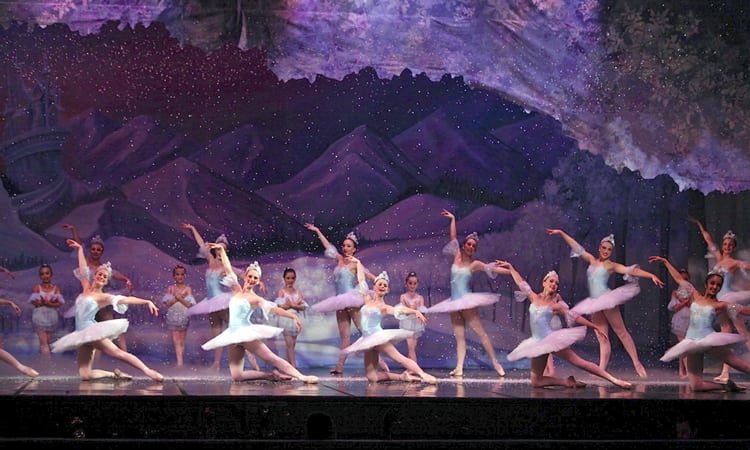
Home » Nutcracker dances its way into holiday traditions
Nutcracker dances its way into holiday traditions

December 8, 2015
[blockquote quote="This is the first time we’ve had dancers from both of those companies — so we’ve very excited to have them" source="Debra Rogo, Artistic Director of the Mid-Columbia Ballet" align="right" max_width="300px"]
TheNutcracker is as synonymous with the holidays as gingerbread cookies and pumpkin spice mochas. For many families, attending a holiday performance is as significant as putting up the Christmas tree.
“The Nutcracker is unique unto itself because it doesn’t really attract a ballet audience,” said Joel Rogo, co-owner of the Tri-Cities Academy of Ballet. “It’s a holiday audience — and the Nutcracker has become part of the holiday season around the country.” The first national Nutcracker performance took place at the San Francisco Ballet in 1944, said Rogo. It quickly went nationwide, dancing its way into the Tri-Cities about forty years ago.
Rogo runs the Tri-Cities Academy of Ballet, while his wife, Debra, is the artistic director of the Mid-Columbia Ballet—the nonprofit arm that produces on the Nutcracker each year. Both organizations operate out of the same building at 21 Aaron Drive in Richland. While the Tri-Cities Academy of Ballet offers private dance instruction, the Mid-Columbia Ballet is comprised of about 60 amateur ballet dancers, separated into senior, intermediate and junior companies.
The annual Nutcracker production is the Mid-Columbia Ballet’s main fundraiser and is projected to bring in $118,000 this season. That money is used to pay for various dance activities and expenses.
“The Nutcracker makes money — and generally art costs money,” said Debra Rogo. “So generally everything else the Mid-Columbia Ballet does through the year, we do with the money we make from the Nutcracker.”
While the Tri-Cities Academy of Ballet is a separate, for-profit organization, many of its dancers also auditioned to be part of the holiday performances.
There are 167 people in this year’s cast, including two guest stars. Vanessa Zahorian, of the San Francisco Ballet, will play the part of the Sugar Plum Fairy. The grand finale of the show is the dance between the Sugar Plum Fairy and her cavalier, played by Gonzalo Garcia, a principal dancer for the New York City Ballet. Garcia’s performance with Zahorian this December will not be the couple’s first time on stage together.
“They both used to dance together in the San Francisco Ballet, then he moved, so they’re very excited to be dancing together again,” said Debra Rogo. “This is the first time we’ve had dancers from both of those companies — so we’ve very excited to have them.”
Zahorian and Garcia are the only paid performers in the show, but Debra Rogo said it’s important to bring in high caliber dancers, not only for the audience, but also for the other performers.
“It’s important for the education of the dancers we train to be able to see the professional standard and be inspired,” she said. “It’s hard to be inspired to be something when you’ve never see that something in person. Exposing our dancers to a professional caliber is very valuable to them.” Although none of the other dancers are paid to perform in the Nutcracker, they do not have to pay a fee to participate in the production. Rogo explained that many amateur companies like the Mid-Columbia Ballet, have parents pay for their child to perform in shows like the Nutcracker. There are audition fees, participation fees, costume rentals and more that can make it expensive for dancers.
“We are unique in that we charge no fee for your child to participate,” said Joel Rogo, who helps out as the Nutcracker’s production manager and serves on the Mid-Columbia Ballet’s board of directors. “All we ask is that you donate your time.” It takes roughly 100 volunteers to put on a show each night, said Debra Rogo. Backstage, there’s a wardrobe, makeup and stage crews, as well as people looking after younger performers.
In the front of the auditorium, volunteers sell nutcrackers, mementos and refreshments.
“It takes a lot of people,” said Debra Rogo. “We even have six or seven people whose entire job is to just iron clothes.” The Nutcracker will be at the Richland High School auditorium, which can seat an audience of up to 1,500, said Joel Rogo. The Mid-Columbia Ballet even had a set specifically designed for the space in 1997. Joel Rogo said the set, which cost the company more than $70,000, was professional designed in Seattle.
“I figured it’d take years to raise the money for the set,” he said. “But I took the renderings out to the community and showed it around, and we raised the money in one year. It was a joy when I got to call the designer and say, ‘Go!’”
The community outpouring for the arts has also spurred fundraising efforts for a new performing arts center at Vista Field. However, the new location would only be able to seat about half the number of people. That information, coupled with the fact that the Mid-Columbia Ballet has a set designed for use at Richland High School, leads the Rogos to believe they’ll keep the holiday performance at the same location.
The high school auditorium also allows the nonprofit group to seat more elementary school children that they bus in annually from area schools.
“We do two performances that are not open to the general public,” said Joel Rogo. “We bus them in from all over and perform for about 3,000 fifth graders. Since 1991, 67,000 kids have seen the Nutcracker. For many, it will be the only ballet they ever see.”
The Nutcracker will be at 7 p.m. Dec. 11 and Dec. 12. Matinee performances will be at 2 p.m. Dec. 12 and Dec. 13.
Tickets are on sale now and can be purchased online at midcolumbiaballet.org. Sunday shows typically sell out first, said Debra Rogo.
“The earlier you get in,” she said, “the better chance you have at getting your seats.”
[panel title="More Information" style="info"]The Nutcracker will be at 7 p.m. Dec. 11 and Dec. 12. Matinee performances will be at 2 p.m. Dec. 12 and Dec. 13.
Tickets are on sale now and can be purchased online at www.midcolumbiaballet.org. Sunday shows typically sell out first, said Debra Rogo.
“The earlier you get in,” she said, “the better chance you have at getting your seats.”
Topics Local News Arts & Culture
KEYWORDS november 2015





